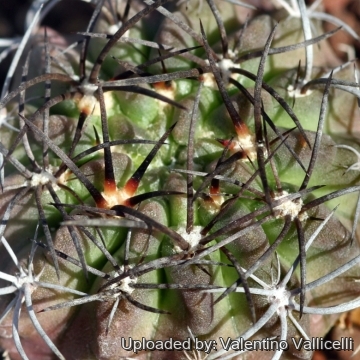Accepted Scientific Name: Eriosyce recondita (F.Ritter) Katt.
Eriosyce (Cactac.) gen. revis. & ampl. (Succ. Pl. Res., 1) 117 (1994)

Eriosyce recondita var. vexata Photo by: Valentino Vallicelli
FR1055 (Collector Friedrich Ritter) Morro Moreno, 02 Antofagasta, Chile. Even if the original plants came from habitat, many of the specimens now in cultivation are hand pollinated and it is hard to believe there isn't some contamination going on under these conditions.
That isn't to say this isn't vexata, or is, just that some no doubt are hybrids.
Origin and Habitat: Morro Moreno, Antofagasta, Chile
Altitude range: 600-950 metres above sea level.
Synonyms:
See all synonyms of Eriosyce recondita
back
Accepted name in llifle Database:Eriosyce recondita (F.Ritter) Katt.Eriosyce (Cactac.) gen. revis. & ampl. (Succ. Pl. Res., 1) 117 (1994)Synonymy: 19
Accepted name in llifle Database:Eriosyce recondita subs. iquiquensis (F.Ritter) Katt.Eriosyce (Cactac.) gen. revis. & ampl. (Succ. Pl. Res., 1) 117 (1994)Synonymy: 7
back
Description: Eriosyce reconditaSN|2876]]SN|2876]] var. vexata (formerly Pyrrhocactus vexatusSN|2885]]SN|2885]]), appears to be a dwarf, weakly spined ally of Neoporteria aricensisSN|2891]]SN|2891]] (syn: Eriosyce reconditaSN|2876]]SN|2876]]), but not sufficiently differentiated and considered merely a local variant of the latter (if not the same) and it is hard to tell apart one from the others, if not for the geographical provenance. It is a spherical, sometimes branching cactus species barely protruding from the ground surface.
Stem: Grey to dark green about 5,5 cm across.
Root: Taproots expanded, often with necks.
Ribs: About 13, 5- 10 mm high, notched and forming tubercles and often with sunken areoles.
Spines: Thin, needle-like, yellow-brown to black, becoming grey; centrals 1-2, 1-3 cm long, upcurved; radial s 10-16, 8-15 mm long.
Flowers: Borne on young areoles, funnelform, 2 x 2 cm, scales of pericarpel and tube with dense woolly hairs and sometimes bristles, tube very short. Perianth pale yellow. Style and stigmas yellow.
Fruit: Club-shaped, elongate, hollow 1-2 (or more) cm long, 1-1.5 cm, dark red or reddish brown, dehiscing by basal pores.
More...Subspecies, varieties, forms and cultivars of plants belonging to the Eriosyce recondita group
- Eriosyce recondita (F.Ritter) Katt.: has grey-green stems 2-5 cm across and white to pinkish flowers. Distribution: close vicinity of Antofagasta.
- Eriosyce recondita subs. iquiquensis (F.Ritter) Katt.: has dark green stems 3-10 cm across and yellow flowers. Distribution from Tocopilla, Antofagasta to Iquique, Tarapaca.
 Eriosyce recondita var. vexata (F.Ritter) A.E.Hoffm.: appears to be a dwarf, weakly spined ally of E. recondita. Distribution: Morro Moreno, Antofagasta, Chile.
Eriosyce recondita var. vexata (F.Ritter) A.E.Hoffm.: appears to be a dwarf, weakly spined ally of E. recondita. Distribution: Morro Moreno, Antofagasta, Chile. - Neoporteria aricensis (F.Ritter) Donald & G.D.Rowley: stem spherical, eventually cylindric and decumbent with time to 5,5 cm across. Flowers pale yellow. Distribution: South of Arica, Tarapacá, Chile.
Bibliography: Major references and further lectures
1) Guerrero, P., Saldivia, P., Faundez, L. & Walter, H.E. 2013. Eriosyce recondita. The IUCN Red List of Threatened Species. Version 2015.2. <www.iucnredlist.org>. Downloaded on 22 July 2015.
2) Fred Kattermann “Eriosyce (Cactaceae): The Genus Revised and Amplified” David Hunt, 1994
3) Edward Anderson “The Cactus family” Timber Press, Incorporated, 2001
4) James Cullen, Sabina G. Knees, H. Suzanne Cubey "The European Garden Flora Flowering Plants: A Manual for the Identification of Plants Cultivated in Europe, Both Out-of-Doors and Under Glass" Cambridge University Press, 11/August /2011
5) David R Hunt; Nigel P Taylor; Graham Charles; International Cactaceae Systematics Group. "The New Cactus Lexicon" dh books, 2006
6) “Bosque” Vol. 8, N. 1, page 25, 1987 ISSN 0304-8799
7) G. Fischer “Excerpta botanica: Taxonomica et chorologica. Sectio A”, 1963
8) Curt Backeberg “Die Cactaceae: Handbuch der Kakteenkunde” Volume 6 G. Fischer, 1962
9)Ritter, "Kakteen in Sudamerika" 1980
More... Eriosyce recondita var. vexata Photo by: Valentino Vallicelli
Eriosyce recondita var. vexata Photo by: Valentino VallicelliSend a photo of this plant.The gallery now contains thousands of pictures, however it is possible to do even more. We are, of course, seeking photos of species not yet shown in the gallery but not only that, we are also looking for better pictures than those already present.
Read More...











